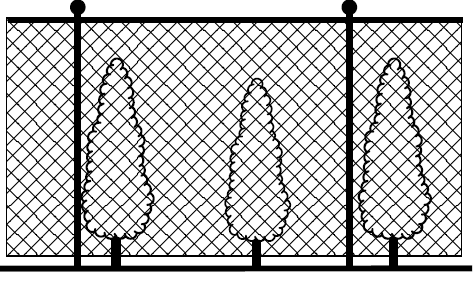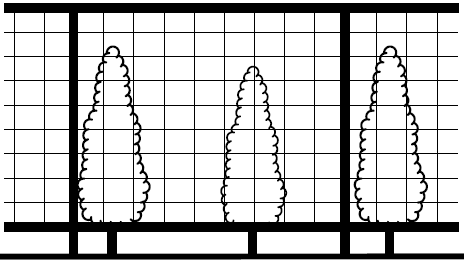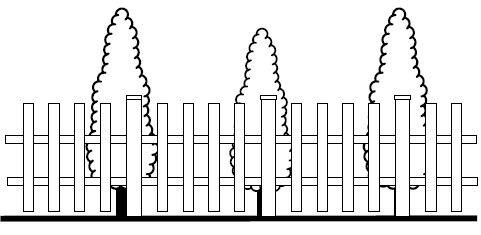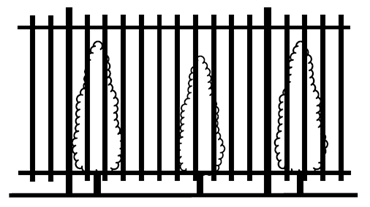Chapter 14.52
FENCES, HEDGES AND WALLS
Sections:
Part I. General Requirements
Part II. Fences and Hedges
Part III. Retaining Walls and Rockeries
14.52.110 Wall or Rockery Exceptions
Part I. General Requirements
14.52.010 Permits Required.
(a) Fences. A fence taller than seven feet shall require a building permit meeting the requirements of the International Building Code (IBC).
(b) Retaining Walls. A building permit shall be required for all retaining walls four feet and higher in height, measured from the bottom of the footing. Building permits shall be required for all retaining walls with a surcharge. All retaining walls over four feet in height from the bottom of the footing shall be engineered by a professional engineer registered in the State of Washington. (Ord. 1063, Sec. 2 (Exh. B), 2019)
14.52.020 Safety.
(a) Sight Triangle. No fence, wall, hedge, structure or other obstruction shall act as a sight hazard to traffic or pedestrians by limiting sight lines for vehicles at locations such as roads, alleys, driveway intersections and where vehicles cross sidewalks. There shall not be anything constructed or reconstructed, and no obstruction permitted, contrary to this chapter or within the sight triangle area as required by City of Lake Stevens Engineering Design and Development Standards (EDDS).
(b) Utilities and Easements. No fence, hedge, wall or other structure may adversely impact utility or access easements. (Ord. 1063, Sec. 2 (Exh. B), 2019)
14.52.030 Maintenance.
All fences, walls and hedges shall be maintained in a condition of repair so as not to be dangerous to human life or a danger to the property subject to the requirements of this chapter and Chapter 14.32, Nonconformities. (Ord. 1063, Sec. 2 (Exh. B), 2019)
Part II. Fences and Hedges
14.52.035 Purpose.
The purpose of this chapter is to provide regulations for fences and hedges that promote privacy, security and screening of certain uses from streets and other uses, while minimizing obstruction of views, light, air, and motorists’ and pedestrians’ vision, without negatively affecting the community or endangering public or vehicle safety. (Ord. 1063, Sec. 2 (Exh. B), 2019)
14.52.040 Height - Setbacks.
(a) Fence or hedge height shall be measured as the vertical distance between the finished grade at the base of the fence or hedge to the top edge of the fence material or hedge.
(b) Solid fences may be a maximum height of four feet within required front yard setbacks. Open fences as detailed in Section 14.52.050 are allowed up to six feet high within the front setback.
(c) Solid hedges may be a maximum height of four feet within required front yard setbacks; there is no height limit in other areas of a property, if the sight triangle is maintained.
(d) All fences in residential zones are allowed up to a maximum height of six feet within required exterior side or rear yard setbacks subject to Section 14.52.030.
(e) If the fence includes a gate or similar feature, a vehicle refuge area shall be provided within the driveway to avoid blocking the street. The vehicle refuge area shall have a length that is sufficient for a waiting vehicle and not block the street.
(f) No fence or freestanding wall shall be placed closer than three feet to any fire hydrant or utility cabinet.
|
Lot Type |
Setback Location |
||
|---|---|---|---|
|
Residential |
|||
|
Residential |
Front |
Side |
Rear |
|
Standard Lot |
4 feet (solid fencing and hedges) 6 feet (open fencing) |
6 feet1 |
6 feet1 |
|
Corner Lot |
4 feet (solid fencing and hedges) 6 feet (open fencing) |
6 feet1 |
6 feet1 |
|
Double-Fronting (Through) Lot |
4 feet (solid fencing and hedges) 6 feet (open fencing) |
6 feet1 |
6 feet1 |
|
Commercial/Industrial/Public |
|||
|
Commercial |
4 feet (solid fencing and hedges) 6 feet (open fencing) |
10 feet |
10 feet |
|
Industrial |
10 feet |
10 feet |
10 feet |
|
Public/Utility |
6 feet (open fencing) |
8 feet |
8 feet |
Notes:
1. Height can go to seven feet if the top foot is open fencing or ornamental, per Section 14.52.050.
(Ord. 1063, Sec. 2 (Exh. B), 2019)
14.52.050 Design.
(a) Screening Options along Streets with Continuous Fencing. Where 80 feet or more of continuous fencing abuts a public sidewalk or trail, landscaping shall be required between the fence and the property line to mitigate the aesthetic impacts using one of the following:
(1) Installation of a three-foot landscape buffer between a solid fence over four feet high. The landscape buffer/planter strip shall be a Type C screen per Section 14.76.040 comprised of a combination of trees and shrubs and/or ground cover based on available space; or
(2) Where planter strips are required along local access and collector roads, constructed as part of new subdivisions, the planter strip may be reversed with the sidewalk, so that the planter strip is adjacent to the property line and outside of the right-of-way.
(b) No landscape setback is required between an open fence and sidewalk when the fencing is comprised of materials such as wrought iron, wood fences with wide openings, vinyl coated chain-link or other similar materials that have 60 percent open space between the ground surface and the top of the fence as illustrated below:
|
Figure 1 |
|
Figure 2 |
|
|
|
|
|
Chain-Link Fencing |
|
Hog Wire Fencing |
|
Figure 3 |
|
Figure 4 |
|
|
|
|
|
Picket Fencing |
|
Wrought Iron Fencing |
(c) Allowed ornamental fencing features may include open trellises, arbors, decorative caps or similar ornamental features.
(d) Barbed Wire and Electric Fences.
(1) Barbed wire is permitted on top of a solid or chain-link fence for commercial, industrial, utility and public uses when needed for security as part of the overall fence height, so long as the barbed wire is positioned in such a way that it leans inward towards the enclosed area. Barbed wire use in residential zones to control livestock will be considered with an approved pasture plan. Razor/concertina wire is not allowed.
(2) Electric fences are not allowed, except in residential zones to control livestock electric fences will be considered with an approved pasture plan. (Ord. 1063, Sec. 2 (Exh. B), 2019)
14.52.060 Fence Exceptions.
(a) The director or designee may allow modifications, per Section 14.16C.120, to fences that do not conform to the regulations of this chapter or in the following situations if the Director finds that such fences are needed to protect the public health and safety:
(1) Outdoor recreation establishments or park and recreation facilities; or
(2) To prohibit illegal dumping; or
(3) Where the finished grade is a different elevation on either side of a fence the height may be measured from the side having the highest elevation.
(b) As part of approving fences under this section, the Director may impose conditions or limitations on fences allowed under this section to ensure that such fences conform with the purpose and intent of this chapter and this title. (Ord. 1063, Sec. 2 (Exh. B), 2019)
Part III. Retaining Walls and Rockeries
14.52.070 Purpose.
Walls and rockeries provide different functions and purposes depending upon need, ranging from landscaping walls that are solely for aesthetic purposes to retaining walls or rockeries that support structural loads and surcharges. Additionally, walls may be needed where fill exists or is proposed versus needing a wall to stabilize a natural slope. (Ord. 1063, Sec. 2 (Exh. B), 2019)
14.52.080 Height.
(a) Retaining walls and rockeries shall be limited to the following heights within setbacks as measured by the International Building Code (IBC):
(1) Front setback: three feet.
(2) Side and rear setbacks: eight feet. (Ord. 1063, Sec. 2 (Exh. B), 2019)
14.52.090 Critical Areas.
All walls proposed to be located adjacent to critical areas or buffers shall comply with Chapter 14.88. (Ord. 1063, Sec. 2 (Exh. B), 2019)
14.52.100 Design.
(a) Screening Options for Continuous Walls and Rockeries along Streets. Where 80 feet or more of continuous walls or rockeries six feet or higher abut a street, sidewalk or pedestrian path, landscaping or screening shall be required between the wall and the right-of-way or easement line to mitigate the aesthetic impacts of such walls and rockeries using one or more of the following options:
(1) Provide cascading vegetation from the top of the wall or rockery - at maturity the cascading screen should not contain openings more than 10 feet wide, per Figure 1 below; or
Figure 1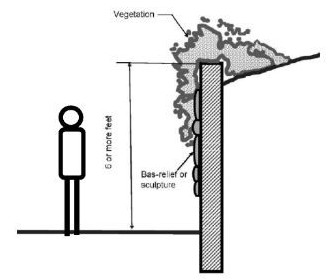
Adapted from Bothell Municipal Code
(2) Provide a three-foot landscape buffer between the wall or rockery (see Figure 2 below). The landscape buffer/planter strip shall be a Type C screen per Section 14.76.040 comprised of a combination of trees and shrubs and ground cover based on available space; or
Figure 2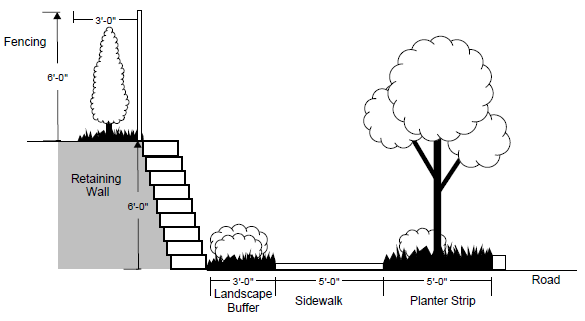
Landscape Buffer Option
(3) Where planter strips are required to be constructed along local access and collector roads, as part of new subdivisions or a public improvement, the planter strip may be reversed with the sidewalk, so that the planter strip is adjacent to the property line/easement and outside of the right-of-way; or
Figure 3
Planter Strip Swap Buffer Option
(4) Walls or rockeries visible from public pedestrian areas shall comply with blank wall treatments in the City’s adopted design guidelines.
(b) Walls or rockeries shall not exceed eight feet in height within setbacks or 12 feet in height outside of setbacks. Exception: A wall that is outside of one setback but crossing perpendicular into either a side or rear yard setback may be 12 feet. (Ord. 1063, Sec. 2 (Exh. B), 2019)
14.52.110 Wall or Rockery Exceptions.
The Planning and Community Development Director, in consultation with the Public Works Director, may approve a modification to wall or rockery heights if the modification is necessary because of the size, configuration, existing topography or location of the subject property. Modifications are to be processed in accordance with Chapter 14.16C, modifications, and may be approved when the following conditions are met:
(a) The modification will not be materially detrimental to the public welfare or to abutting properties; and
(b) The modification will reduce potential adverse impacts to critical areas;
(c) The modification will retain a greater number of significant trees;
(d) The modification will permit the installation of transportation improvements; or
(e) The alternative separation, slope gradient, or height is in the public interest. (Ord. 1063, Sec. 2 (Exh. B), 2019)



